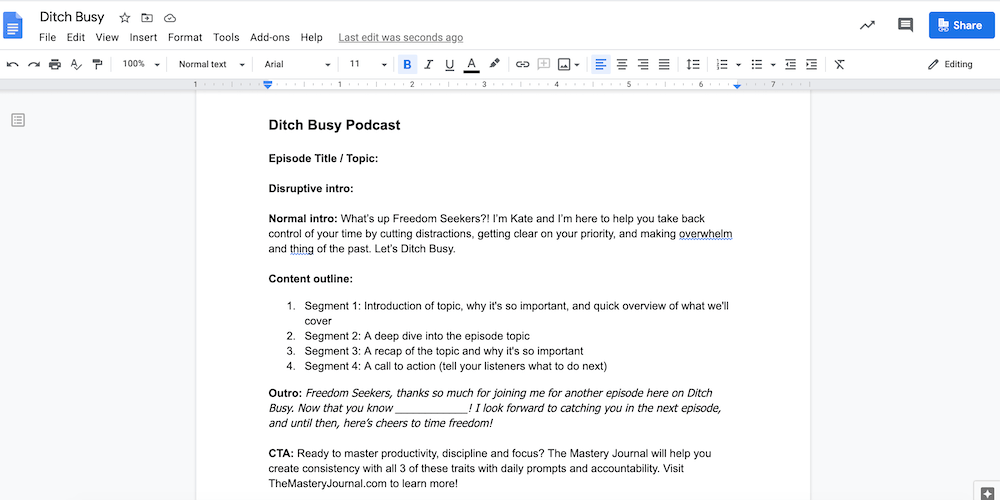There’s a lot that goes into creating and producing a podcast. Whether it’s an interview podcast, a topic podcast, a podcast you’re doing with a co host, or anything else, something to consider is what podcast segment ideas you can use to create a great episode.
Podcast Segment Ideas
While not every episode has to be the same, coming up with specific segments you’ll use for different types of content is a way to help make creating and producing your show easier, kind of like writing a podcast script.
In order to help you get set up, we’re going to first look at different topic ideas, then we’ll dive into 5 different podcast segment ideas, and we’ll wrap with ways to make your podcast fun on a consistent basis!
What are Some Good Podcast Topics?
The beautiful thing about podcasting is that there is something for everyone, and that means you get to pick a topic for your podcast based on something you’re actually interested in and passionate about!
You definitely want to make sure there’s an audience out there who wants and needs the content you’re sharing, too, and a great way to confirm this is to know who your avatar is.
A good podcast topic is also going to be niche. So don’t go podcasting about marketing strategies or how to become an entrepreneur. The podcasting space is too crowded for broad topics that try to talk to everyone.
Going Even More Niche
If you’re excited to create a podcast around the topic of marketing strategies, what kind of marketing strategies specifically?
- Instagram marketing strategies
- Amazon marketing strategies
- Email marketing strategies
So when looking for good podcasting topics, brainstorm how your passions and experiences intersect. Then, post on social media or reach out to a dozen friends or contacts who you feel would be your avatar for this podcast.
Share your ideas with them, then ask these questions:
- What is your biggest struggle right now when it comes to [insert topic for podcast]
- Where do you currently go for content on [insert topic]
- What’s one of your biggest goals right now as it relates to [insert topic]
Hearing answers to these questions from your ideal listeners will help confirm whether your idea is worth pursuing.
And do your due diligence to see if there’s anyone else already talking about your topic. If yes, that’s PROOF OF CONCEPT – a great thing!
Follow their content, and ask yourself:
- How can I do this differently?
- How can I do this better?
If you’re still feeling stuck around the best topic for your podcast, join us in our completely Free Podcast Course where we share 8 videos tutorials that walk you through how to create and launch your podcast!
How do you segment a podcast?
Once you’ve chosen your podcast topic and you’re ready to start creating content, it’s a great idea to consider how you might segment your podcast and/or your individual episodes.
Segmenting Your Podcast
One example is to produce your podcast in a season-based format. So instead of publishing episodes once per week indefinitely, you could release a season on your podcast all at once, or drip the content out over a six-week period, and then take a break.
A season-based format is great if you have specific topics you want to dive deep on, or if you’re looking for a production schedule that gives you a few breaks throughout the year.
I’ve used seasons on my podcast for both of these purposes: to do a deep dive on a specific topic, and to give myself a break every 2-3 months.
Don’t get too held up on what a season is “supposed to look like”. There are multiple different ways to produce seasons, and this is your podcast. Get creative, and find a schedule that feels right for you.
Segmenting Your Episodes
Another option is to break up your individual episodes. Let’s take a look at 5 ideas for podcast segments based on the format of your podcast.
1. Topic-based podcast
If you’re creating a topic-based podcast (one where you dive into a specific topic as the podcast host without any guests), then you can look at your episode segments as the headings of an outline.
For example:
- Segment 1: Introduction of topic, why it’s so important, and quick overview of what we’ll cover
- Segment 2: A deep dive into the episode topic
- Segment 3: A recap of the topic and why it’s so important
- Segment 4: A call to action (tell your listeners what to do next)
This type of format can help drastically cut down your preparation time and help create even more value within each of your episodes. With a clear outline to follow and certainty around what comes next, your preparation time can potentially be cut in half!
2. Interview-based podcast
If you’re creating an interview-based podcast (you are inviting guests on to discuss a specific topic), then you can look at your episode segments as transition points for the interview.
For example:
- Segment 1: Introduce your guest & share why they’re perfect for today’s episode and content
- Segment 2: Ask your guest 3-4 questions that will provide maximum value to your listeners
- Segment 3: Ask your guest for their top recommendation or takeaway they’d like to share
- Segment 4: A call to action (tell your listeners what to do next)
When conducting an interview-based podcast, it can be really helpful to actually communicate this episode flow to your guest ahead of time. That way they can come prepared.
3. Q&A podcast
If you’re creating a Q&A podcast, then your episode segments can be very simple.
For example:
- Segment 1: Ask the question
- Segment 2: Provide your answer
- Segment 3: A call to action (tell your listeners what to do next)
A great tool for Q&A podcasts is called SpeakPipe. This software allows you to quickly and easily add a widget to your website or landing page where your audience can record and send their questions to you.
Your audience loves feeling involved, so whether you’re doing a Q&A podcast or not, having shout outs or voice recordings is a great way to keep your listeners involved and engaged.
4. Co-host podcast
If you’re creating a podcast alongside someone else, then your episode segments could be how you and your co-host know who’s turn it to talk.
For example:
- Segment 1: You introduce the episode and share what your audience can expect
- Segment 2: Host 1 breaks down Point 1
- Segment 3: Host 2 breaks down Point 2, and so on…
- Segment 4: A call to action (tell your listeners what to do next)
When you use segments for your podcast episodes in these ways, you’re making sure you have a flow to follow and that everyone is on the same page. Not only will this help save you production time, but it’ll also make sure creating and recording your episodes goes smoothly.
5. Variety podcast
If you’re looking to create a variety podcast that incorporates two or more of the format options above, that’s a great idea!
A variety show gives you a lot of options, so based on which formats you’ll be rotating you can simply use the flows and segments from each type above.
Keep in mind that if you do go with a variety podcast, it’s best to keep things consistent.
For example, if you’re going to do a mix of topic-based, interview-based, and Q&A episodes, then have them go live on the same day each week. Maybe your topic-based episodes release on Mondays, your interview-based episodes release on Wednesdays, and your Q&A episodes release on Fridays.
That way you AND your listeners know what to expect!
How do you make a podcast fun?
Now that you’ve chosen a topic and you have some podcast segment ideas, let’s take a look at some ways to make a podcast fun!
Your personality
Be unique! Your audience tunes into your podcast because they like YOU! Of course, they’re tuning in for the podcast episode value, too, but always remember: when someone presses play on an episode, they’re doing it because they WANT TO!
So make it fun for your audience by being you. Share your quirks, insert stories, include fun facts from your past… and this is another great segment idea! Use the first minute of your episodes to share a fun fact about yourself that most people don’t know!
Engage!
Regardless of your topic, it’s critical to keep your audience engaged throughout every one of your episodes.
How do you keep your listeners engaged? Here are a few more segment ideas you can use at the top, middle, or end of your podcast episodes.
- Give your listeners shout outs! You can read reviews people have left, or give someone kudos for reaching out to you via social media
- Create fun transitions. You can do this with the help of music or sound effects. Those breaks in the content can be incredibly helpful when you’re looking to keep your listeners engaged
- Be approachable! Your listeners will likely want to reach out to you – to share their biggest takeaways, ask questions, or just to say “thanks!” So make it easy for them to do so! Share your email address and your handle on your favorite social media channels, and then repeat #1 above :)
Other touch points
Podcasting is an incredible medium, but it doesn’t have to be your only medium!
If you’re doing a podcast on the latest news, create an Instagram account where you share top takeaways from each episode, and then encourage your listeners to connect with you there.
If you’re doing a podcast about cooking, start an email list just for your podcast listeners where you share recipes from each episode, or shopping lists they can download.
Creating other touch points outside of your podcast will not only help you keep your listeners engaged, it’ll also help you continue to build a stronger relationship with them.
The Evolution of Your Podcast
Don’t feel like everything has to be perfect right from the start. The truth is, it won’t be. So embrace that and just start! You can tweak, pivot, and make improvements along the way. The most important thing you can do for the success of your podcast is to start right now, and then dedicate yourself to constantly improving along the way.
Think of your podcast as an evolution; it will change and shift as you try new things and become better at your craft. If you’re looking for even more great tips on creating, growing, and monetizing your podcast, be sure to check out our completely free Podcast Masterclass!
You’ve got this!

